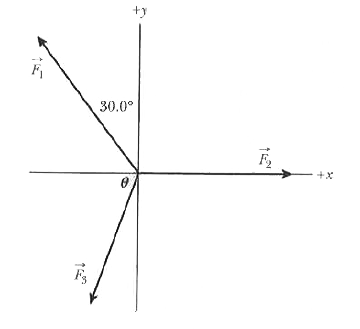A particle is acted on by two torques about the origin: →τ1 has a magnitude of 2.0N⋅m and is directed in the positive direction of the x axis, and →τ2 has a magnitude of 3.0N⋅m and is directed in the nagative direction of the y axis. In unit-vector notation, find →dl/dt, where →l is the angular momentum of the particle about the origin.
To solve the problem, we need to find the time rate of change of angular momentum, denoted as d→Ldt, which is equal to the net torque acting on the particle.
1. Identify the Given Torques:
- The first torque →τ1 has a magnitude of 2.0N⋅m and is directed along the positive x-axis. In unit vector notation, this can be expressed as:
→τ1=2.0N⋅m^i
- The second torque →τ2 has a magnitude of 3.0N⋅m and is directed along the negative y-axis. In unit vector notation, this can be expressed as:
→τ2=−3.0N⋅m^j
2. Calculate the Net Torque:
- The net torque →τnet is the vector sum of the two torques:
→τnet=→τ1+→τ2
- Substituting the values:
→τnet=(2.0^i)+(−3.0^j)=2.0^i−3.0^j
3. Relate Torque to Angular Momentum:
- According to the relationship between torque and angular momentum, we have:
d→Ldt=→τnet
- Therefore, we can express the time rate of change of angular momentum as:
d→Ldt=2.0^i−3.0^j
4. Final Expression:
- The final expression for the time rate of change of angular momentum in unit vector notation is:
d→Ldt=2.0^i−3.0^jN⋅m/s
- The first torque →τ1 has a magnitude of 2.0N⋅m and is directed along the positive x-axis. In unit vector notation, this can be expressed as:
→τ1=2.0N⋅m^i
- The second torque →τ2 has a magnitude of 3.0N⋅m and is directed along the negative y-axis. In unit vector notation, this can be expressed as:
→τ2=−3.0N⋅m^j
- The net torque →τnet is the vector sum of the two torques:
→τnet=→τ1+→τ2
- Substituting the values:
→τnet=(2.0^i)+(−3.0^j)=2.0^i−3.0^j
- According to the relationship between torque and angular momentum, we have:
d→Ldt=→τnet
- Therefore, we can express the time rate of change of angular momentum as:
d→Ldt=2.0^i−3.0^j
- The final expression for the time rate of change of angular momentum in unit vector notation is:
d→Ldt=2.0^i−3.0^jN⋅m/s
Topper's Solved these Questions
- BOOK - RESNICK AND HALLIDAYCHAPTER - RIGID BODY DYNAMICS - IEXERCISE - PRACTICE QUESTIONS (SINGLE CORRECT CHOICE TYPE)43videos
RIGID BODY DYNAMICS - I
- BOOK - RESNICK AND HALLIDAYCHAPTER - RIGID BODY DYNAMICS - IEXERCISE - PRACTICE QUESTIONS (MORE THAN ONE CORRECT CHOICE TYPE)7videos
RIGID BODY DYNAMICS - I
- BOOK - RESNICK AND HALLIDAYCHAPTER - RIGID BODY DYNAMICS - IEXERCISE - CHECKPOINT18videos
RIGID BODY DYNAMICS - I
- BOOK - RESNICK AND HALLIDAYCHAPTER - RELATIVITYEXERCISE - PRACTICE QUESTIONS (Integer Type)5videos
RELATIVITY
- BOOK - RESNICK AND HALLIDAYCHAPTER - RIGID BODY DYNAMICS-IIEXERCISE - PRACTICE QUESTIONS (Integer Type)2videos
RIGID BODY DYNAMICS-II
Similar Questions
vector →a lies in the xy plane, has a magnitude of 18 units, and points in a direction 250∘ from the positive direction of the x axis. Also, vector →b has a magnitude of 12 units and points in the positive direction of the z axis. What is the vector product →c=→a×→b ?
View SolutionFind a Vector in the direction of →a=ˆi−2ˆj that has magnitude 7 units.
View Solution
Knowledge Check
- Question 1 - Select One
A particle of mass 1kg is moving alogn the line y=x+2 with speed 2m/sec. The magnitude of angular momentum of the particle about the origin is
A4kg−m2/secB2√2kg−m2/secC4√2kg−m2/secD2kg−m2/sec - Question 2 - Select One
Three forces are applied to an object, as indicated in the drawing. Force →F1 has a magnitude of 21.0 newton (21.0N) and is directed 30.0∘ to the left of the +y axis. Force →F2 has a magnitude of 15.0 N and points along the +x axis. What must be the magnitude and direction (spectified by the angle θ in the draeing) of the third force →F3 such that the vector sum of the three force is 0 N ?
 A16.9N,81∘B20.4N,75∘C22.3N,79∘D18.7N,76∘
A16.9N,81∘B20.4N,75∘C22.3N,79∘D18.7N,76∘ - Question 3 - Select One
Find the torque about the origin when a force of 3ˆj N acts on a particle whose position vector is 2ˆk m
A5ˆjNmB−6ˆiNmC6ˆkNmD6ˆiNm
A single force acts on a particle situated on the negative x-axis. The torque about the origin is in the positive z-direction. The force is
View SolutionVector →A, which is directed along an x axis, is to be added to vector →B, which has a magnitude of 6.0 m. The sum is a third vector that is directed along the y axis, with a magnitude of →AFind the magnitude of →A ?
View SolutionFind the torque about the origin when a force of 3ˆj N acts on a particle whose position vector is 2ˆk m
View SolutionA particle of mass m = 5 units is moving with a uniform speed v=3√2 units in the XOY plane along the line Y = X + 4. The magnitude of the angular momentum of the particle about the origin is
View SolutionA particle of mass m=5 unit is moving with a uniform speed v=3√2 unit in the XOY plane along the line y=x+4 the magnitude of the angular momentum of the particle about the origin is
View Solution

